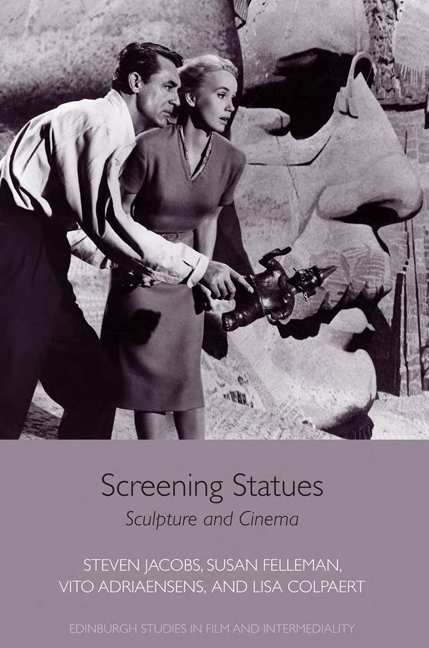Book contents
- Frontmatter
- Contents
- List of Figures
- Acknowledgements
- Introduction: The Marble Camera
- PART I
- 1 The Sculptor's Dream: Living Statues in Early Cinema
- 2 The Mystery … The Blood … The Age of Gold: Sculpture in Surrealist and Surreal Cinema
- 3 Carving Cameras on Thorvaldsen and Rodin: Mid-Twentieth- Century Documentaries on Sculpture
- 4 Anatomy of an Ovidian Cinema: Mysteries of the Wax Museum
- 5 The Night of the Human Body: Statues and Fantasy in Postwar American Cinema
- 6 From Pompeii to Marienbad: Classical Sculptures in Postwar European Modernist Cinema
- 7 Of Swords, Sandals, and Statues: The Myth of the Living Statue
- 8 Coda: Returning the Favor (A Short History of Film Becoming Sculpture)
- PART II
- Bibliography
- About the Authors
- Index
3 - Carving Cameras on Thorvaldsen and Rodin: Mid-Twentieth- Century Documentaries on Sculpture
from PART I
Published online by Cambridge University Press: 23 June 2018
- Frontmatter
- Contents
- List of Figures
- Acknowledgements
- Introduction: The Marble Camera
- PART I
- 1 The Sculptor's Dream: Living Statues in Early Cinema
- 2 The Mystery … The Blood … The Age of Gold: Sculpture in Surrealist and Surreal Cinema
- 3 Carving Cameras on Thorvaldsen and Rodin: Mid-Twentieth- Century Documentaries on Sculpture
- 4 Anatomy of an Ovidian Cinema: Mysteries of the Wax Museum
- 5 The Night of the Human Body: Statues and Fantasy in Postwar American Cinema
- 6 From Pompeii to Marienbad: Classical Sculptures in Postwar European Modernist Cinema
- 7 Of Swords, Sandals, and Statues: The Myth of the Living Statue
- 8 Coda: Returning the Favor (A Short History of Film Becoming Sculpture)
- PART II
- Bibliography
- About the Authors
- Index
Summary
“An object in space is a better proposition for a film on art than a two-dimensional work like a painting, an illuminated manuscript, or a goblin,”1 Josef Paul Hodin wrote in his review of Looking at Sculpture (Alexander Shaw, 1949), a film focusing on statues in the Victoria and Albert Museum. Indeed, cinema has consistently been presented as the perfect instrument with which to document sculpture. “Short of a field trip, the best way to teach sculpture is with cinematic visual aids,” Sally Chappell wrote in 1973:
The flow of images and the inherent motion of changing camera distance and angle simulate the live three-dimensional experience of sculpture better than a series of front, side, and back view slide reproductions. The cinema can also reproduce the movement of light, so important in rendering the material of sculpture – the shifting reflections in Brancusi's metals, for example, or the glowing transparencies in Pevsner's plastics.
Given this perspective, it is not a coincidence that the earliest examples of “art films,” which date from the first two decades of the twentieth century, had monuments and public sculptures as their subject. While often being actualities showing inaugurations of public statues, many of these films focus on the social event of the ceremony rather than the sculptures themselves, but some films did give attention to the plastic qualities of the sculptures in natural light. While a cinematic reproduction of a painting seemed useless or redundant, the medium of film was considered perfect for visualizing three-dimensional artworks, which necessitate a moving approach to grasp their different angles and spatial dimension. Likewise, German art film pioneer Hans Cürlis, who founded the Institut für Kulturforschung in 1919 in order to develop and propagate film as a mediator for art, considered paintings highly “unfilmic.” Throughout the 1920s, Cürlis made several films that consist of static shots of sculptures rotating on their axis, grouped under titles such as “Heads,” “Negro Sculpture,” “Old-German Madonnas,” “German Saints,” “Kleinplastik,” “Indian Crafts,” or “East-Asian Crafts.” Other landmark art documentaries produced before the Second World War also focused on sculpture.
- Type
- Chapter
- Information
- Screening StatuesSculpture and Cinema, pp. 65 - 83Publisher: Edinburgh University PressPrint publication year: 2017



